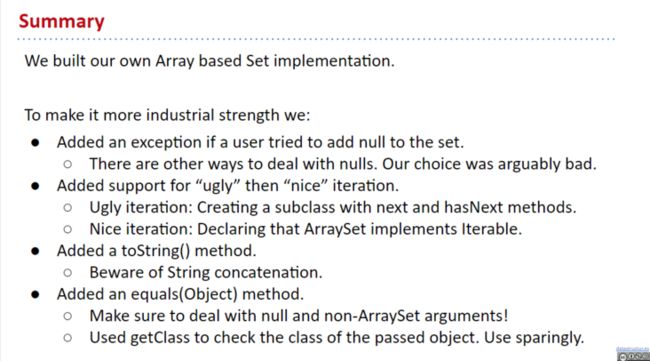(在2020后的版本把2018写的ArrayMap改成了ArraySet,因此下面的案例基于ArraySet)
所有的类都隐式地继承了Object,且包含Object的以下方法:
- String toString()
- boolean equals(Object obj)
- Class getClass()
- int hashCode()
- protected Objectclone()
- protected void finalize()
- void notify()
- void notifyAll()
- void wait()
- void wait(long timeout)
- void wait(long timeout, int nanos)
本次课我们重点介绍前两个方法
1.toString()
当你每次调用System.out.println(x)时,无论x原本的类型是什么,都会发生隐式地转换,System.out.println(Object x) calls x.toString() 即
(If you’re curious: println calls String.valueOf which calls toString)
String x = x.toString();
System.out.println(x);默认的Object的toString()方法转换的格式为:
classname @ hex_memory
类名@十六进制内存地址因此如果打印我们自己写的ArraySet,其结果是:
$ java ArraySetPrintDemo
ArraySet@75412c2f
但是Java.util内置的List,Set,Map均Override了Object原来的toString()方法,因此如果我们使用内置的List:
public static void main(String[] args ) {
List a = new ArrayList<>();
a.add(1);
a.add(2);
a.add(3);
System.out.println(a);
} 就会打印出赏心悦目的结果:
[1, 2, 3]我们的目标是,让我们自己写的ArraySet也打印出这种漂亮的结果,也就是我们需要Override原本的toString()
先回顾一下我们的ArraySet:
public class ArraySet implements Iterable {
private T[] items;
private int size; // the next item to be added will be at position size
public ArraySet() {
items = (T[]) new Object[100];
size = 0;
}
/* Returns true if this map contains a mapping for the specified key.
*/
public boolean contains(T x) {
for (int i = 0; i < size; i += 1) {
if (items[i].equals(x)) {
return true;
}
}
return false;
}
/* Associates the specified value with the specified key in this map.
Throws an IllegalArgumentException if the key is null. */
public void add(T x) {
if (x == null) {
throw new IllegalArgumentException("can't add null");
}
if (contains(x)) {
return;
}
items[size] = x;
size += 1;
}
/* Returns the number of key-value mappings in this map. */
public int size() {
return size;
}
@Override
public String toString() {
/* hmmm */
}
@Override
public boolean equals(Object other) {
/* hmmm */
}
public static void main(String[] args) {
ArraySet aset = new ArraySet<>();
aset.add(5);
aset.add(23);
aset.add(42);
//toString
System.out.println(aset);
} 解决方案:
@Override
public String toString() {
String returnString = "{";
for (int i = 0; i < size; i += 1) {
returnString += keys[i];
returnString += ", ";
}
returnString += "}";
return returnString;
}这样的toString()虽然能实现我们的目标,但是效率上非常低,这是因为Java中,String是不变量(还记得不变量吗?回顾一下以前的笔记),因此当每次执行字符串拼接时:
returnString += keys[i];Java都是从头创建一个新的副本,然后再将字符拼接,最后返回该副本,因此,假设拼接一个字符需要1s,对字符串"{ 1 2 3 }"进行拼接,则需要
- { (1s)
- { + 1 = { 1 (2s)
- { + 1 + 2 = { 1 2 (3s)
- { + 1 + 2 + 3 = {1 2 3 (4s)
- { + 1 + 3 + } = {1 2 3} (5s)
可见每次拼接都是从头开始,上述过程的总耗时为1 + 2 + 3 + 4 + 5 = 15s
如果一个字符串的长度为n,则以上面的算法拼接字符串的时间复杂度是 O(1 + 2 + 3 + 4 +......+ n-1 + n) = O(n(n-1)/2),即O(n²)
如何让字符串拼接变得更加高效?
为了解决这个问题,Java 有一个特殊的类,称为StringBuilder. 它创建一个可变的字符串对象,因此您可以继续追加到同一个字符串对象上,而不是每次都创建一个新对象。
使用StringBuilder重写toString()方法:
public String toString() {
StringBuilder returnSB = new StringBuilder("{");
for (int i = 0; i < size - 1; i += 1) {
returnSB.append(items[i].toString());
returnSB.append(", ");
}
returnSB.append(items[size - 1]);
returnSB.append("}");
return returnSB.toString();
}此算法的时间复杂度是线性的,O(n)
2.equals() vs. ==
前面我们有提到 Object.equals(Object o)方法是比较两个Object的值,而Java中 == 则是比较二者的内存地址是否相同,或者说是否指向同一Object
举例:

因此以后如果要比较两个Object通常意义下的相等,请使用.equals()
但是事实上,Java的Object.equals()方法默认是与 == 等效的,在内置的Java.util 的Set,Map,List均Override了原本的equals(),因此我们使用起来才没问题
如果我们原封不动地使用默认的equals()方法,同样会相当于使用 == 判断两个内存地址不同的Object,从而返回false:
因此我们的目标是Override默认的equals()方法,使之适用于我们的ArraySet
请注意 List是有序元素集合,Set是无序元素集合。因此,如果我们需要重写自定义的ArrayList的equals(),需要逐项比较两个List中的元素是否顺序相同且元素值相等
而Set是唯一元素的无序集合。因此,要将两个集合视为相等,您只需要检查它们之间是否相互包含相同的元素。
解决方案:
@Override
public boolean equals(Object other) {
if (this == other) {
return true;
}
if (other == null) {
return false;
}
if (other.getClass() != this.getClass()) {
return false;
}
ArraySet o = (ArraySet) other;
if (o.size() != this.size()) {
return false;
}
for (T item : this) {
if (!o.contains(item)) {
return false;
}
}
return true;
} getClass()方法是返回当前Object的class type,例如this.getClass() = ArraySet.class
总结:
3.Even Better toString() and ArraySet.of()
String.join()
实现字符串拼接还有一种方法,使用String.join()
@Override
public String toString() {
List lisOfItems = new ArrayList<>();
for(T x : this) {
lisOfItems.add(x.toString());
}
return "{" + String.join(",", lisOfItems) + "}";
} .Of()
回忆一下以前做过的lab,我们以 .Of()方式创建一个List,或者Set,例如:
Set javaset = Set.of(5, 23, 42); 就能创建一个Set,其内容为{5,23,42},非常的方便
因此,我们想实现属于自己的.Of()方法,使之能够达到上面的效果
解决方案:
public static ArraySet of(Glerp... stuff) {
ArraySet returnSet = new ArraySet<>();
for (Glerp x : stuff) {
returnSet.add(x);
}
return returnSet;
} 语法点:
- 泛型方法,在方法返回类型前加
,前面笔记有介绍 - Varargs: ... 可变长度参数
在 Java 5 中提供了变长参数,允许在调用方法时传入不定长度的参数。变长参数是 Java 的一个语法糖,本质上还是基于数组的实现,Java的可变参数,会被编译器转型为一个数组
void foo(String... args);
void foo(String[] args);更多可见this link
